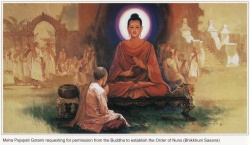Difference between revisions of "Nine great ordeals"
m (Text replace - "1" to "1") |
|||
| Line 18: | Line 18: | ||
[http://www.sgilibrary.org/search_dict.php www.sgilibrary.org] | [http://www.sgilibrary.org/search_dict.php www.sgilibrary.org] | ||
[[Category:Buddhist Terms]] | [[Category:Buddhist Terms]] | ||
| − | [[Category:Buddha Shakyamuni]] | + | [[Category:Buddha Shakyamuni]]{{BuddhismbyNumber}} |
Latest revision as of 10:41, 22 April 2014
nine great ordeals
[九横の大難] (Jpn kuo-no-dainan )
Also, nine great persecutions. The major hardships that Shakyamuni Buddha underwent.They are listed in The Treatise on the Great Perfection of Wisdom and other Buddhist works, but differ slightly according to the source. A well-known account of the nine ordeals follows:
(1) At the instigation of a group of Brahmans, a beautiful woman named Sundari spread rumors to the effect that she was having an affair with Shakyamuni.
(2) Brahmans mocked Shakyamuni when a maidservant gave him an offering of stinking rice gruel in a Brahman city.
(3) Agnidatta, a Brahman in Vairanja, invited Shakyamuni and five hundred disciples to his mansion, but was so completely absorbed in the pursuit of pleasure that he neglected to make them any offerings. For a period of ninety days, they had nothing to eat but oats used as horse fodder.
(4) King Virudhaka of Kosala killed a great many members of the Shakya clan, to which Shakyamuni belonged.
(5) When Shakyamuni entered a Brahman city, the king forbade the people to make offerings or listen to him.
(6) A Brahman woman named Chinchatied a tub to her belly under her robe and claimed that she was pregnant by Shakyamuni.
(7) Devadatta pushed a boulder from atop a cliff on Shakyamuni in an attempt to crush him. It missed its mark, however, injuring only his toe.
(8) Once, around the time of the winter solstice, an icy wind rose and continued to blow for eight days. Shakyamuni and his disciples were particularly vulnerable since they were away from the monastery and had no permanent shelter. Shakyamuni protected himself from the cold wind by wearing three robes made of discarded rags, the only garments permitted a monk.
(9) King Ajatashatru loosed a drunken elephant and set it upon Shakyamuni and his disciples in an attempt to have them trampled to death.
